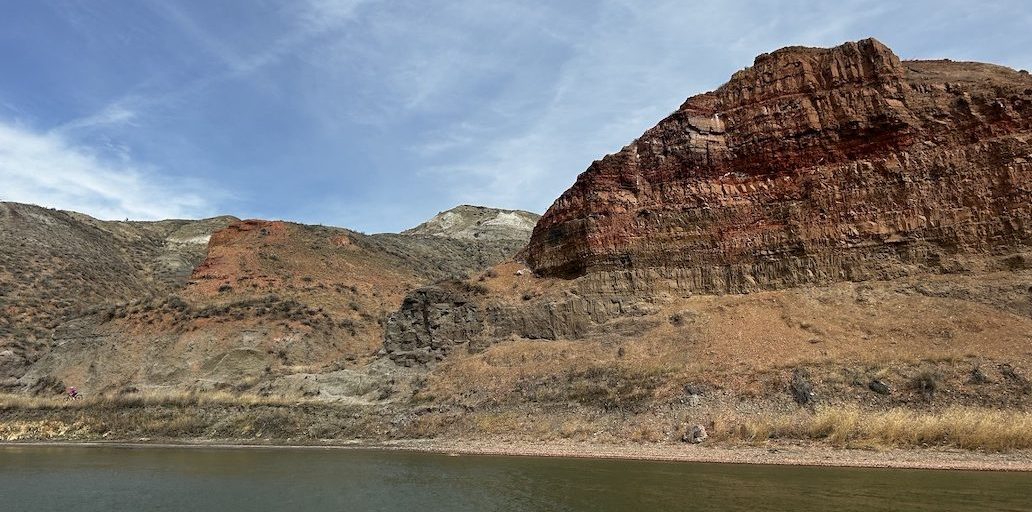The Boyce lab made a strong showing at the recent joint conference between the Alberta Chapter of The Wildlife Society and Canadian Section of The Wildlife Society Conference in Jasper last month. Seven grad students from the lab, as well as Dr. Mark Boyce, presented talks and posters on their various research projects.
We would like to congratulate 3rd year PhD student Ian Gazeley for winning the prestigious Bill Wishart Award for his graduate research on big horn sheep disease ecology. Ian presented a poster at the conference and please see below to read his abstract and view his poster.
Abstract: Transmission of disease and pathogens from domesticated animals presents a substantial risk to native species. Populations of wild sheep are at high risk from the novel bacterium Mycoplasma ovipneumoniae (M.ovi) which occurs at high rates in domestic caprid herds (30-70% of operations). The mountains and foothills of southwest Alberta, Canada are home to significant populations of Rocky Mountain bighorn sheep (Ovis
canadensis canadensis) that have experienced both historic and recent disease outbreaks associated with exposure to domestic livestock. To evaluate the risk of transmission to bighorns, and predict spread of disease among bighorn populations, a collaborative project between the University of Alberta, the Alberta Government, Parks Canada, and multiple NGOs was initiated to provide a thorough understanding of movement behaviours, habitat selection, and metapopulation connectivity in the region. In 2022-2023 a total of 70 bighorn rams 1.5 – 9.5 years old (median 4.5) were aerial net-gun captured (n=61) or chemically immobilized (n=9) and fitted with GPS collars. Preliminary analyses of data collected between April 2022 and October 2023 suggest patterns of migration, dispersal and foray are highly variable among individuals and herds. Average daily movement were 3.55 km (2.03 – 5.57) in summer (Apr. 1 – Oct. 31) and 3.14 km (1.07 – 5.67) in winter (Nov. 1 – Mar. 31). Total distance travelled averaged 753.5 km (434.7 – 1010.0) in summer, and 452.1 km (176.7 – 697.9) in winter. Local convex hull estimates (K=25) of annual home range averaged 69.6 km2 (10.3 – 242.7). Next steps include habitat selection, migration, corridor and foray analyses.
Ian Gazeley poster:
Additionally, congratulations also goes to 2nd year MSc student Kathryn Vaughan on winning 1st place for her poster presentation on the effects of winter severity on hunter sccuess on mule deer. Please see below to view her abstract and poster.
Abstract: White-tailed deer (Odocoileus virginianus) and mule deer (O. hemionus) playcrucial roles in Alberta’s ecosystems and economy, impacting vegetation, predator-preydynamics, hunting practices, and overall biodiversity. However, no studies have addressed the combined effects of winter severity and hunting on deer populations across Alberta, which can lead to unpredictable harvest fluctuations. We aim to fill this knowledge gap bycomprehensively documenting factors influencing deer harvest fluctuations, especiallyduring periods of low hunter success, to inform effective management strategies. To achieve this, we will develop a Winter Severity Index (WSI) to predict winter severity invarious regions across the province, identify drivers of deer hunter success (e.g., winter severity, Normalized Difference Vegetation Indices, hunting), and explore a potential Hydra Effect—a phenomenon wherein harvests foster populations stabilization through density dependence and harvest interaction. Leveraging data from the Government of Alberta, Forestry and Parks, historical WSIs, and NASA Daymet V4 satellite weather data, we will assess hunter success responses to WSIs and analyze the impact of varying hunting pressure on harvest. This research significantly contributes to wildlife management and conservation in Alberta, bridging knowledge gaps and offering insights into hunter success and harvest fluctuations. The study benefits hunters and conservation authorities alike, emphasizing the positive role of hunting in conservation efforts. By developing a predictive Winter Severity Index and understanding factors shaping deer populations, our research aims to ensure the health and stability of white-tailed and mule deer populations amid Alberta’s evolving environmental and economic landscape.
Kathryn Vaughan poster:
